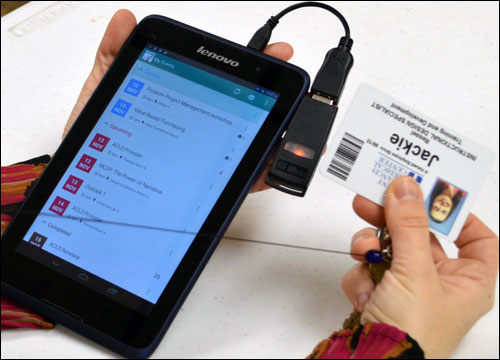Each month, Saint Francis Medical Center, located in Cape Girardeau, Mo., holds 100 training sessions for its employees. Every one of the facility’s 2,500 staff members attends some kind of training, which is provided in the hospital campus’ classrooms on a regular basis. The sessions cover a range of topics, including medical updates, organizational changes, software and system management, maintenance procedures and, most recently, Ebola safety procedures. Consequently, the medical center has a large volume of attendance records that it must collect and manage.
In the past, the hospital tracked session attendance manually, via paper and pen. This required that personnel write their own ID numbers onto a piece of paper and initial the page, in order to prove they attended. Others then had to input the IDs into the hospital’s Learning Management software for each session. This could create errors if workers forgot to write on the paper, or if the ID numbers were transposed or illegible.

A year ago, the hospital adopted DotEnablers‘ i-Attend Web event attendance-tracking solution, along with desktop readers provided by RF IDeas. Every hospital employee has a low-frequency (LF) 125 kHz RFID-enabled proximity badge encoded with a unique ID number assigned to that particular staff member in the company’s software. The RFID tags built into badges are provided by HID Global, and the hospital had used the badges for the purpose of access control prior to the i-Attend solution’s installation. The RFID-enabled i-Attend Web solution worked fine, says Eric Desa, Saint Francis Medical Center’s e-learning specialist, but it required that the hospital provide the readers with either an Ethernet or wireless connection to the Internet. That was not always convenient, he says, since sessions are spread throughout various parts of the campus, and are sometimes organized very quickly—too quickly for a reader to be set up and connected to Saint Francis’ Internet network.
Consequently, Desa says, several months after adopting the i-Attend Web solution, he began working with DotEnablers and RF IDeas to develop a mobile solution. The result, according to Marlon Bermas, DotEnablers’ founder, is i-Attend Mobile, an Android-based app loaded onto a tablet or smartphone fitted with an RF IDeas dongle reader. The solution is now being offered to other customers for tracking the attendance of company personnel.
Saint Francis Medical Center tested the mobile solution earlier this year, and is now using it on a daily basis with several tablets that have readers plugged into their USB ports.
With the system in place, data regarding sessions being offered is stored in the i-Attend cloud-based software. Each night, the medical center’s training program department downloads data related to the coming day’s sessions onto the tablets to be used. Those tablets are then charged during the night, and are assigned to staff members who manage attendance the next day.
When an employee arrives onsite for a training session, she taps her ID badge next to the RF IDeas dongle reader connected to a tablet device that is either in the possession of onsite employees or, in the future, could be mounted to the wall of the session room’s entrance area. The reader captures the badge’s ID number and stores it along with the session information. A worker can later upload that data to the i-Attend software, once the tablet has established an Internet connection, by selecting the prompt for synching. The software then identifies which employees attended which particular session, and forwards that data to the hospital’s Learning Management software. The software can also track when each employee is due for specific training, and can issue alerts if he needs to take a session to, for instance, maintain his certification.
Desa says he looked into several attendance-tracking solutions before selecting the I-Attend application with RF IDeas readers. The advantage to using the RF IDeas readers, he explains, was not only that they would work with the staff’s existing RFID badges, but also that they were well accepted in the health-care industry for attendance-tracking applications.
Ray Galang, RF IDeas’ regional sales manager for the Midwest, says LF was the frequency most optimal for this application, due to of its close read range—1 or 2 inches, at most—which eliminates stray reads of badges that are in the vicinity but not actually entering a session room.
Desa expects to acquire approximately 15 tablets to manage all sessions offered each day. In addition, he says, the hospital could use the RFID-enabled tablets for an asset-management solution. In such a scenario, he notes, the staff could utilize the tablets to document the loaning of medical equipment to a specific worker, by reading both the ID encoded to that person’s badge and those of the passive LF RFID tags applied to equipment. In so doing, the hospital could create a record of who took which item, as well as when this occurred. According to Desa, Saint Francis Medical Center will discuss a potential asset-tracking solution with DotEnablers.



